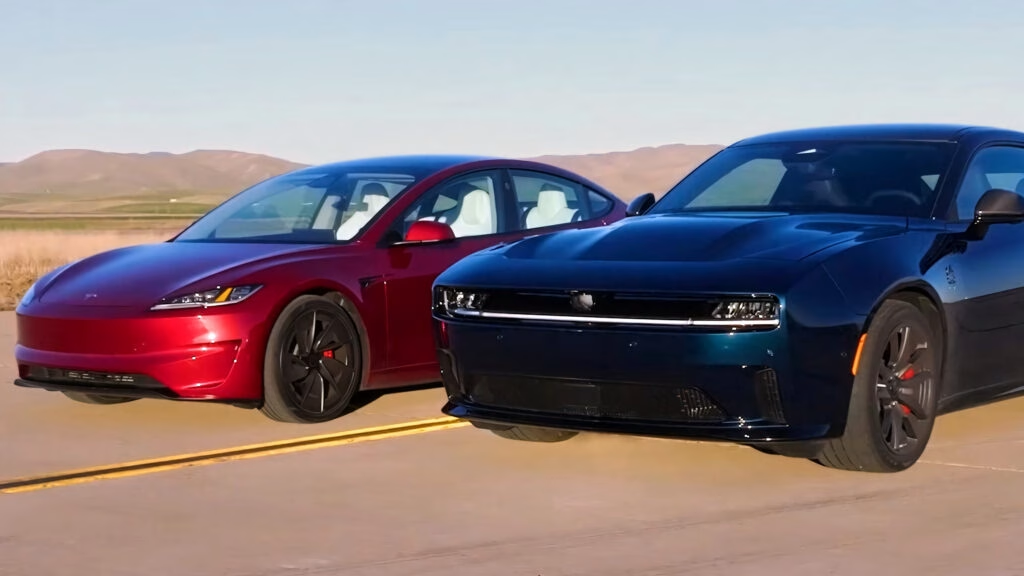How Does the Dodge Charger Daytona Scat Pack Compare to the Tesla Model 3 Performance?
The automotive landscape is shifting rapidly, especially as electric vehicles (EVs) gain traction. One of the most talked-about matchups recently has been between the Dodge Charger Daytona Scat Pack and the Tesla Model 3 Performance. Both cars represent different philosophies in performance and design, but how do they stack up against each other in real-world conditions?
Performance: Who Takes the Lead?
When it comes to raw acceleration, the Tesla Model 3 Performance has a clear edge. With its dual electric motors generating 510 horsepower and 554 lb-ft of torque, it boasts a 0-60 mph time of just 2.9 seconds. In contrast, the Charger Scat Pack, with its impressive 670 horsepower and 627 lb-ft of torque, claims a 0-60 time of 3.3 seconds. However, in actual tests, the Model 3 outperformed the Charger, clocking a best 0-60 time of 3.1 seconds compared to the Charger’s 3.7 seconds.
But it’s not just about the numbers. The Tesla continues to pull ahead even after the initial launch, showcasing its superior acceleration capabilities. During a quarter-mile run, the Model 3 finished in 11.3 seconds at 122.1 mph, while the Charger lagged behind at 12.0 seconds and 118.7 mph. This performance gap highlights the Tesla’s efficiency and power delivery, which are hallmarks of electric vehicles.
Handling: A Tale of Two Approaches
While the Charger may have the upper hand in terms of horsepower, the Model 3 shines in handling. The Tesla’s more predictable and neutral handling allows it to navigate tight corners with ease, making it a joy to drive on winding roads. Edmunds noted that the Model 3 performed a quicker U-turn, further emphasizing its agility.
Interestingly, the Charger did excel in lateral grip, achieving a peak of 1.19G compared to the Tesla’s 1.13G. This means that while the Charger might feel more planted during aggressive cornering, it still struggles to keep pace with the Tesla in overall performance.
Price Considerations: Is It Worth the Investment?
Price is always a significant factor when considering a new vehicle. The Tesla Model 3 Performance starts at around $56,630, while the Charger Daytona Scat Pack begins at $70,190. This nearly $28,000 difference is substantial, especially when both vehicles qualify for the $7,500 federal tax credit.
For many buyers, the Tesla offers better value for money, especially considering its performance metrics. However, fans of the Charger may argue that the visceral experience of driving a muscle car is worth the extra cost. It’s a classic debate: raw power and nostalgia versus cutting-edge technology and efficiency.
The Future of Performance Cars
The reception of the Charger Daytona has been mixed, to say the least. Critics have pointed out its bulkiness and lack of the excitement that the classic V8-powered Challenger delivered. Dodge’s decision to discontinue the base Daytona R/T model for the 2026 model year reflects the challenges they face in the evolving automotive market.
As electric vehicles continue to dominate discussions about the future of performance cars, manufacturers like Dodge will need to adapt. The Charger Daytona Scat Pack may still have its fans, but the undeniable performance of the Tesla Model 3 Performance sets a high bar for what consumers expect from modern vehicles.
So, what’s the big takeaway? The battle between electric and traditional muscle cars isn’t just about numbers; it’s about the driving experience and what you value in a vehicle. Whether you lean towards the thrill of the Charger or the efficiency of the Tesla, both cars offer unique experiences that cater to different automotive enthusiasts. Start by test-driving both, and you might just find your next favorite ride.

